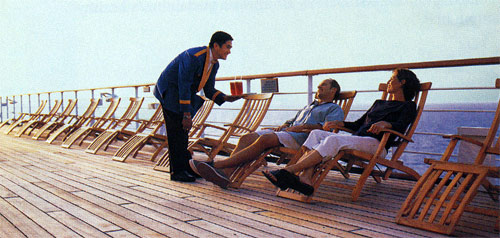 Out of some 8,000 hotel officers and crewmembers working aboard Holland America Line’s (HAL) ships, more than 1,000 of them have notched 10-plus years of service with the cruise line – an impressive statistic. The figure is but one indicator of HAL’s solid workplace culture, said Wayne Byers, the cruise line’s vice president of human resources.
Out of some 8,000 hotel officers and crewmembers working aboard Holland America Line’s (HAL) ships, more than 1,000 of them have notched 10-plus years of service with the cruise line – an impressive statistic. The figure is but one indicator of HAL’s solid workplace culture, said Wayne Byers, the cruise line’s vice president of human resources.
“I think our strongest point has been consistency and our ability to adapt to a changing industry,” Byers said. “For example, in the aftermath of September 11, our bookings fell off, but we maintained employment and didn’t cut any jobs…it’s the kind of consistency that’s allowed us to be viewed as a premium employer.”
For HAL’s hotel operations officers and crew – the majority of which are, and have historically been, Filipino and Indonesian – working at sea offers the kind of income potential that’s rarely matched shoreside. “We offer superior professional opportunities,” Byers said. “The decision to go to sea is a fairly complicated one, and it boils down to a lifestyle choice. Even if working at sea is not in a crewmember’s long term plans, they still manage to learn a great deal about hospitality in their time on a ship and can go back ashore and be prepared to work in four-star and five-star hotels.
Since cruise lines know firsthand that a happy crew makes for happy – and often repeat – passengers, it’s hard to underestimate the importance of having a well-taken-care-of crew. Living conditions aboard HAL ships, said Byers, are excellent, and many diversions and programs are offered to crewmembers to help ensure their contentment. Crew are accommodated in double-occupancy cabins and are matched up generally by nationality and job function, Byers said.
“We think our Vista-class ships are setting the stage for new standards for crewmembers,” Byers said. “They’re state of the art in terms of ship design, and because the ships are larger, they’ve allowed us to offer more to our crew.” For example, crewmembers have their own Internet cafes in addition to the requisite bars, exercise facilities and game rooms.
Hands-On Training
HAL has its own training facility in Indonesia, called MS Nieuw Jakarta (which began in 1981 as the SS Jakarta), where all dining stewards, restaurant staff, cabin stewards and room service attendants go to learn the ropes. “It’s skills-based training,” Byers said, adding that trainees live at the school during the 10-12 week program.
The program in Jakarta allows potential crewmembers to get a feel for exactly what the job entails. It’s not just typical classroom training, either: mock cabins are set up for trainees, who also must pass stringent written and conversational English tests. “Since our crew are the prime contacts with our guests, we can’t emphasize the importance of English skills enough,” Byers said. HAL also offers culinary training in Manila and a comprehensive beverage-service training program that all restaurant staff complete before going to sea.
The Jakarta program – besides providing invaluable hands-on experience – is a good way for a potential crewmember to gauge their ultimate interest in a career at sea. “There are people who enter the training program who find out that this might not be what they thought it would be,” Byers said. Indeed, it’s better to find out that the career’s not a good fit while on dry land.
HAL also has a “buddy system” on its ships to help out new crew on board. “We find that the buddy system helps with orientation, especially if someone hasn’t been to sea before,” Byers said. Crewmembers can also address specific needs to their supervisors, who will follow up with the crew until an issue is resolved. Byers said there’s also a Filipino and Indonesian representative on board each ship – elected by the crew to represent each nationality with HAL – that work with management in order to resolve whatever issue that may come up.
HAL also has an institutionalized “compassionate leave” program, whereby crewmembers can leave a ship in the case of a family emergency and return when the issue has been resolved. “We grant them a leave period and try to get them back on the ship as soon as possible,” Byers said. “It’s not unlike policies that most U.S. companies have.” Crewmembers also enjoy complete medical coverage while on board; national medical plans cover the crewmembers when they are shoreside. HAL, Byers said, also provides a life insurance program.
As for advice Byers would lend to someone considering a career at sea? The most important thing, he noted, is to have a clear plan. “You should be able to think through and ask yourself, Am I going to set goals for myself, and are these goals consistent with what HAL has to offer?’ We provide promotional opportunities for people who are going to lend themselves to training and work on excellent job performance.”
Down Time
The centerpiece of crew life outside of work is the shipboard “crew activity committee,” which meets on a weekly basis to plan events for the crew – both on the ship and shoreside. Inter-ship communication will also allow for the occasional shoreside soccer match or other sporting event, which leads to an overall sense of camaraderie for crewmembers. Byers noted that HAL offers shore excursions to crewmembers, depending on schedules. “If one ship finds a neat thing to do, others learn about it and it could be fleet wide,” Byers said.
Excerpt from the Cruise Industry News Quarterly Magazine: Winter 2004-2005



